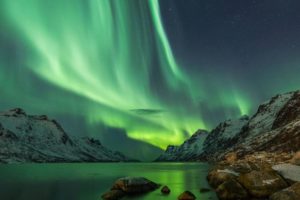A polar wilderness of grinding ice and frozen seas, the Arctic – defined by scientists as the area which falls within the line of latitude 66.5 degrees north of the Equator – is the furthermost northern tip of the planet.
Unfathomably cold and hostile, and yet a place of outstanding haunting beauty, the Arctic is one of the few remaining frontiers that remains virtually uninhabited and untouched by the hand of man. Make no mistake about it; the Arctic is a hardy frozen land of ice and snow that is by turns beautiful and terrifying, serene and then furious; as capricious as it is unforgiving. Many an intrepid adventurer has heeded the call of the Arctic and never returned.
Whilst it might be difficult to believe, this frigid region is in fact teeming with life. Granted, the very heart of the Arctic where the North Pole is to be found is by all intents and purposes a frozen
desert; a wilderness where nature can barely take root in the face of piercing sub-zero winds so cold we couldn’t imagine, but a little further south in the lands of northern Scandinavia, Greenland,
Iceland, Russia, Canada and the US can be found ancient frozen forests, and the mosses and lichens that live on the icy tundra. Polar bears, seals, walrus, caribou, arctic foxes, and reindeer, live
hunt, and breed in the Arctic snow, while the seas that lie below the Arctic’s icy crust are no less rich in life. The cold water is home to a number of whale species, seals, fish, shrimp and crabs, as well as the plankton and algae that nourish and give life to this remarkable marine eco-system. And then, of course, there are the mountainous icebergs and towering white cliffs of the huge glaciers that scientists believe hold 20% of the Earth’s fresh water; their splendour and majesty speaks for itself.
Sadly, like much of the natural world, the Arctic is under threat by the rising temperatures caused by climate change. At the current pace of warming, many climatologists now believe that, come the year 2100, virtually all of the Arctic sea ice will melt each summer – quite aside from the impact this will have on sea levels and, subsequently, coastal-lying cities, this will cause catastrophic damage to Arctic habitats and undoubtedly cause the extinction of many species who live in the area.
If ever there is a time to see these wonderful lands and feel the crisp Arctic wind on your face, the next decade or so would be the time to do it. By taking the bold decision to board a mighty ice-breaker vessel and embark on a truly unique journey to the very tip of the planet, you’ll set-off on an adventure few others ever will. How many people have you invited to dinner who can say they’ve stood on the single earthly spot where every direction that they look is south?
To find out more about such a once-in-a-lifetime experience, you can visit the Quark Expeditions website to find out more: www.quarkexpeditions.com/gb/arctic







